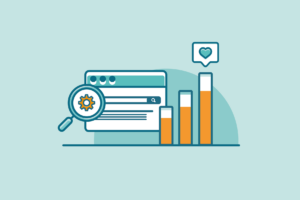
Inbound marketing supports tactics to let potential customers find your product or service themselves, by offering the solution to their problem using content marketing, SEO, PPC and social media marketing.
“96% of people who visit your website are not ready to buy.” - HubSpot
By providing information for people across the buyer’s journey, inbound marketing helps to build trust with visitors to your website and potential customers. It creates a more contextually appropriate experience for people researching their issue or requirements - turning strangers into visitors, leads, customers and finally, promoters of your brand.
Quick recap - buyer’s journey?!
The buyer’s journey is the process every buyer goes through as they become aware of, consider, evaluate and decide on a product or service. This could be as small as lettuce in a supermarket or as big as deciding on what car to buy, or which agency to hire for your business. It could be broken down into many steps, but generally, we look at the following three:
- Awareness - the buyer realises they have a problem
- Consideration - the buyer defines their problem and researches options to resolve it
- Decision - the buyer has chosen how they want to resolve the problem and are “ready to buy”
What does inbound marketing mean?
The definition of what inbound marketing is centres around an approach businesses adopt to attract prospective leads, relying on relevant, online content and marketing automation to nurture leads and guide them through the buyer’s journey. By offering guidance or information at a stage that people might not be ready to purchase yet, your business becomes a leader in the subject and will be front of mind for those ready to make a decision.
What’s the difference between inbound and outbound marketing anyway?
In the past, outbound marketing was the only option available to marketers. It often resulted in a not-very-targeted, scattergun approach, using interruptive marketing tactics. Think direct mail, cold-calling and newspaper advertising to promote your business.
A lot has changed since then. These days consumers have much more control of their decision making process, and are not as reliant on sales people to tell them what to do. Search engines, social media, downloading guides or checklists are all part of the process before an enquiry is even submitted.
“15 years ago the average consumer typically only used two touchpoints when buying an item. Today, consumers use an average of almost six touchpoints with nearly 50% regularly using more than four.” - Marketing Week

Inbound basics
If you are getting started with inbound marketing, this model really helps to understand how the approach wants every part of the business to work together.
The idea is to attract new visitors and convert them into leads. Marketing and sales teams work together to then ‘close’ these leads into customers. By ensuring your new customer has a great experience, delighting them and then sending further marketing to them, you could see a higher percentage re-convert or buy another one of your services.
Attract
At this stage, your marketing team can shine. Creating beautiful and relevant campaigns for your target audience, to attract prospects to your website. In order to offer the right content, to the right person, at the right time, understanding where the prospect is in their buyer’s journey is crucial. Your content should answer questions on how your potential new leads can solve their problem, or satisfy their needs. After all, looking for a new pair of jeans isn’t a problem as such - right?!
At this stage, common inbound marketing tactics that are used include SEO, PPC, social media, content marketing and digital PR.
Convert
You have visitors to your website. Yes - success! The next step is to convert them into leads and grow your database. There are many ways to engage with your prospects and capture their details, so do it in a way that suits them best. You could offer them a downloadable piece of content or an exclusive webinar, in exchange for some of their details. Forms, call to actions and landing pages that are optimised for your campaign can work really well too and once your prospect has made initial contact you can start guiding them by sharing other relevant content with them.
This is where having a CRM system becomes important. You can keep track of the prospects that are coming in, as well as where they are in the buyer’s journey and what content they have engaged with. This will help you nurture these leads and convert them into customers!
Close
Right. So, we have collected leads and shared more relevant content with them. What now? It’s time to turn them into customers. At this stage, it’s all about ensuring that your leads know you are the right choice to solve their problem or satisfy their needs.
Lead nurturing and marketing automation take centre stage in this phase. By setting up email workflows, you can share content and convince your leads, whilst you pick up the phone to follow up with others.
Delight
You’ve made the sale, so now you’re done. Right? Think again! Inbound marketing doesn’t stop once the sale has been made. Delighting your existing customers is paramount for two reasons - you retain or reconvert them as a customer, and you could potentially turn them into a promoter of your brand. Whether they agree to a testimonial or share your social posts, all of this can help people across the buyer’s journey decide to use your business!
Use surveys to get feedback from your customers and monitor your mentions across social media. Referral campaigns could also be useful to your business, bringing in further business, by offering rewards for referrers.
Benefits of inbound marketing
There are many benefits to inbound marketing - I’m not going to put every single one of them here (but if you’re interested, why not read our blog on the benefits of inbound marketing?).
One of the most important reasons to consider inbound marketing services is the return on investment they can see. A more engaged audience will likely spend more, or come back for another one of your products/services.
The beauty of inbound is that customers find you, and will continue to find you, once the campaigns are up and running. As a marketer, you are getting to the right people even whilst you’re asleep, saving you time and money. Winning!
Besides that, applying inbound marketing strategy across the board engages your visitors across the buyer’s journey and will give them a better experience when dealing with you. They’ll then be more likely to return for more and promote you to others!
If you'd like to learn more about the inbound process check out the inbound section of our blog. Alternatively reach out to us for a chat on Twitter.





